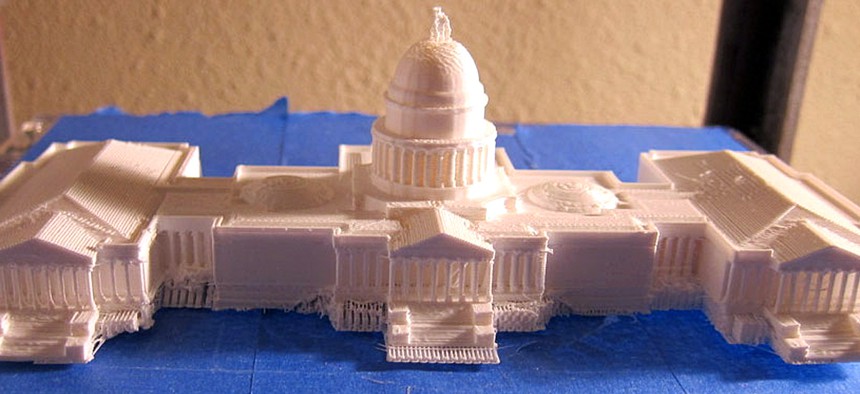Will 3D Printing Be Useful in Government?

A scale model of the U.S. Capitol, printed from a design anyone can find in the Thingiverse repository. Thingiverse
Some of you might remember a time when 2-D printing was not so ubiquitous in government, either.
John Breeden II is an award-winning journalist and reviewer with over 20 years of experience covering technology and government. He is currently the CEO of the Tech Writers Bureau, a group that creates technological thought leadership content for organizations of all sizes. Twitter: @LabGuys
Because I review a lot of products, I often get asked a lot of questions, especially about new technology. Normally, those questions are about how the technology works and how it can fit (or sometimes why it won’t fit) into government. Over the next couple weeks, I hope to share with you my findings on a variety of topics including the recently launched Windows 10 and a fascinating new inkjet-based printing technology, among others.
But this week, I want to answer a question I get asked all the time these days, about whether 3-D printing is a useful tool, or simply a flash in the pan-type fad.
The technology that drives 3-D printing is sometimes also called additive manufacturing because it adds layer upon layer of some type of substrate over and over again to create an object. The plans that drive the printer are not unlike CAD files from many years ago, or perhaps advanced blueprints. They are even more complicated than that though, because they have to take into account the fact that each substrate layer may need to cool or dry before a new layer is added, so pauses are built into the printing process to compensate.
There are two types of people who use 3-D printing: creators and users. Creators are like engineers. They create the files that program the printers and save them in a format that almost every 3-D printer can read. Many of these designs get saved in a repository called the Thingiverse, where you can find things like the Capitol Building design at the top of the page. Users in turn only need to obtain the file and load them into their printer of choice.
There are a few factors to consider, such as if your chosen printer has enough print area to create a design, or if you will need to print it in stages and then assemble it. But for the most part, it’s simply a process of loading up the file and pushing print.
The substrate used by most printers is ABS plastic, though it can be almost anything designed to work with the printer in question. For example, some 3-D printers can work with concrete to build solid structures, and NASA recently gave a company a $125,000 grant to create a unit that could print out food items like brownies and pizza for astronauts in space.
View a video of chocolate 3D printing
Back on Earth, the precision offered by some 3-D printers have helped them find their way into medical applications, such as the National Institutes of Health with its fascinating Heart Exchange library, where surgeons can find and study models of hearts with various defects prior to surgery. That is part of a larger NIH 3D Print Exchange library, which contains all kinds of interesting medical and biological-related objects for government scientists to study.
That said, I think 3-D printing is still really in its infancy at this point. What it does, it does well. I recently got a chance to take a look at the Replicator 2X Experimental 3-D Printer from MakerBot, which is designed for more scientific printing uses and which can be loaded up with two different colors of ABS plastic spools at the same time to go beyond single-color designs. I printed out a variety of tools and prototype designs with the unit, including things that require some ruggedness like hinges and snaps. Everything seemed surprisingly sturdy and I could think of quite a few useful things to make with it, though advanced designs took several hours to print.
I think the biggest problem with 3-D printing right now is twofold. First, there really is no “killer app” that would make people really need to have them. For government, the NIH project is on the right track, but both that and the way NASA is using 3-D printing is fairly specific. I don’t think anyone is going to want to try and print out their pizza when they can just pick up the phone and order one of likely much better quality.
Secondly, while the ABS plastic is surprisingly sturdy as a medium, we really need something a bit sturdier and not so toy-like. Something like steel, but without the 2,500 degrees Fahrenheit melting point requirement.
But 3-D printing might just get there one day. Some of you might remember a time when 2-D printing was not so ubiquitous in government, either. Once the applications and the material strength catches up, 3-D printing might just follow a similar path.
NEXT STORY: NASA Building Flying Space Drones






